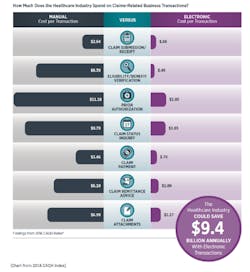There is still plenty of room for improvement regarding electronic business transactions in health care, including dental. A recent CAQH report reveals the opportunity for nearly $10 billion in annual savings by increasing transactions from manual, paper-based processes to electronic ones.
Dental and health-care organizations are currently experiencing widespread adoption of electronic business transactions. However, there is still significant opportunity for nearly $10 billion in annual savings by increasing the migration of transactions from manual, paper-based processes to electronic ones. This information comes from the recently released 2016 CAQH (Council for Affordable Quality Healthcare) Index data, and bolsters what I have been signaling for some time. As a tenured member of the health information exchange community, I’m very familiar with the potential savings that can be achieved using electronic technology. I constantly encourage businesses to move away from paper to more secure electronic solutions, and these recent stats from CAQH reinforce what I think we all know.
According to the CAQH report, conducting resource-intensive manual transactions costs US health plans and health-care providers as much as $11 more per transaction, and on average every manual claim attachment costs $6 more than if it’s handled electronically. With millions of these transactions exchanged daily, it’s not hard to see where that $9.4 billion figure comes from.
According to the study, medical providers, for example, could save a minimum of 1.1 million labor hours per week by transitioning to fully electronic transactions. Providers now spend an average of eight minutes and up to nearly half an hour on manual tasks such as making phone calls, sending faxes, and mailing correspondence.
The potential savings from full industry adoption of electronic transactions has grown by nearly one billion from what CAQH reported in the Index last year. The growth is real and could be tied to the increase in claims attachments, which are used to send additional supporting claims data such as x-rays, perio charts, EOBs for dental and discharge summaries, or operative reports for medical. CAQH reports that 94% of claims attachments are currently submitted manually. Each of these cost nearly $6 more on average to process compared to electronic attachments.
Advances in technology, such as NEA Powered by Vyne’s FastAttach, an electronic claims attachment solution in use by more than 50,000 dental practices for more than 20 years, have likely encouraged greater adoption of electronic attachments. The medical version of FastAttach from Vyne Medical, which provides a secure, 100% electronic attachment solution for medical organizations to submit additional documentation, has also contributed. FastAttach enables dental and medical organizations to submit secure electronic claims attachments to facilitate more rapid claims adjudication.
Also notable in this report is that beyond simply creating medical savings and reducing cost, the CAQH Index tracked adoption of electronic transactions by dental health plans and providers for the second year. I believe this is a great addition to the data because it’s provides better understanding of how secure technology is improving dental practices. Adoption of the four electronic transactions measured for commercial dental health plans was on average 30% lower than adoption by commercial medical health plans. This gap presents a significant savings opportunity for the dental market. Full electronic adoption of the transactions studied could save dental health plans and providers more than $1.9 billion annually.
To encourage greater adoption, the report proposes that the industry share best practices, conduct targeted industry-led efforts to reduce adoption barriers, and perform systemic reviews of current standards, codes, operating rules, and policies. This report makes clear that savings can be found in the health-care ecosystem, but that’s no surprise. What may be surprising to some is that making these savings a reality is easier than most realize. Simple solutions already exist to address the needs of organizations and provide benefits to providers and payers. Vyne has been successfully addressing these needs for more than 20 years and driving down operational costs with simple, inexpensive solutions like FastAttach.
As the CAQH Index reveals, there will be an even greater focus on the importance of electronic claims attachments, technology solutions will continue to drive growth, revenue, and further innovation. With 48 million claims attachment transactions occurring annually in 2015, there’s potentially a lot of cash being left on the table, and certainly a great deal of efficiency to be gained.








